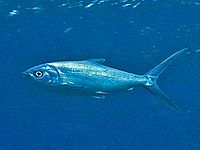
Photo from wikipedia
BACKGROUND Fish is one of the most popular foods for consumers due to its abundant nutrition, tenderness, and delicious taste. With the increasing demand for tilapia fillets, practical preservation is… Click to show full abstract
BACKGROUND Fish is one of the most popular foods for consumers due to its abundant nutrition, tenderness, and delicious taste. With the increasing demand for tilapia fillets, practical preservation is widely used to maintain quality and safety during long-distance transportation and storage. Thus, the effects of polyphenols (2 g/L) on tilapia fillets' color, flavor quality and mechanism were studied during 49 d partial freezing (-4 °C). RESULTS The carnosic acid (CA), procyanidin (PA), quercetin (QE), and resveratrol (RSV) treatment inhibited water migration, myoglobin oxidation and psychrophilic bacteria stability during partial freezing storage. Aeromonas and Acinetobacter were the dominant bacteria of tilapia fillets during -4 °C storage. The relative abundance of aromatic substances (T70/2) in the polyphenol groups (> 20%) was richer than the CON group (17%). PLS-DA analysis results showed that the different odor of the CON and polyphenol groups were completely separated. Moreover, 35 fatty acids were identified by GC analysis. On 49 d, the ratios of UFAs in the PA group (58.64%), QE group (57.70%) and RSV group (57.25%) were higher than the CON group (57.19%), and the PA group was the highest. CONCLUSIONS The polyphenols treatment effectively maintained freshness and improved the quality of tilapia fillets during partial freezing. The polyphenols treatment comprehensively sustained the tilapia fillets' color and flavor quality found in the proposed mechanism. Especially, the PA treatment was considered a potential method for preserving fillets' freshness. This article is protected by copyright. All rights reserved.
Journal Title: Journal of the science of food and agriculture
Year Published: 2022
Link to full text (if available)
Share on Social Media: Sign Up to like & get
recommendations!